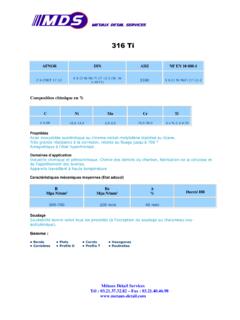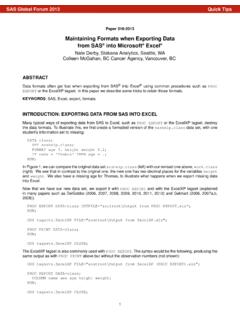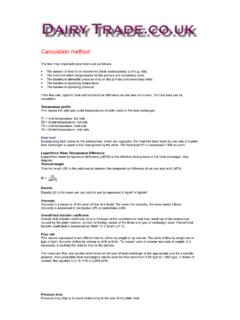Transcription of Relative Corrosion Resistance of Standard …
1 Acme Alloys | TL | Relative Corrosion Resistance of Standard stainless Steel Grades for Different Environments Phone +91-11- 514 3474, 513 3021 | Fax: +91-11-514 6900, 540 5799. e-mail: | - Page 1 of 2 - Relative Corrosion Resistance of Standard stainless Steel Grades for Different Environments Acids Hydrochloric Acid stainless steel is generally not recommended except when solutions are very dilute and at room temperature (pitting may occur). Mixed Acids There is usually no appreciable attack on type 304 or 316 as long as sufficient nitric acid is present. Nitric Acid Type 304, 304L, 430, and some higher-alloy stainless grades have been used. Phosphoric Acid Type 304 is satisfactory for storing cold phosphoric acid up to 85% and for handling concentrations up to 5% in some unit processes of manufacture. Type 316 is more resistant and is generally good for storing and manufacture if the fluorine content is not too high. Type 317 is somewhat more resistant than type 316. At concentrations [85%, the metal temperature should not exceed 100 C (212 F) with type 316 and slightly higher with type 317.]
2 Oxidizing ions inhibit attack. Sulphuric Acid Type 304 can be used at room temperature for concentrations > 80 to 90%. Type 316. can used in contact with sulphuric acid [10 % at temperatures [50 C (120 F) if the solutions are aerated; the attack is greater in air-free solutions. Type 317 may be used at temperatures as high as 65 C (150 F) with 5% concentration. The presence of other materials may markedly change the Corrosion rate. As little as 500 to 2000 ppm of cupric ions, make it possible to use type 304 ni hot solutions of moderate concentration. Other additives may have the opposite effect. Sulphurous Acid Type 304 may be subject to pitting, particularly if some sulphuric acid is present. Type 316 is usable at moderate concentrations and temperatures. Bases Ammonium Hydroxide Steels in the 300 series (302, 303, 304, 308, 309, 310, 316, 317, 347 etc.) generally Sodium Hydroxide have good Corrosion Resistance at virtually all concentrations and temperatures in Caustic Solutions weak bases, such as ammonium hydroxide.]]
3 In stronger bases, such as sodium hydroxide, there may be some attack, cracking, or etching in more concentrated solutions and/or at higher temperatures. Commercial purity caustic solutions may contain chlorides, which will accentuate any attack and may cause pitting of type 316, as well as of type 304. Organics Acetic Acid Acetic acid is seldom pure in chemical plants but generally includes numerous and varied minor constituents. Type 304 is used for a wide variety of equipment including stills, base heaters, holding tanks, heat exchangers, pipelines, fittings, valves, pump parts and pumps for concentrations 99% at temperatures 50 C (120 F). Type 304 is also satisfactory-if small amounts of turbidity or colour pick up can be tolerated-for room-temperature storage of glacial acetic acid. Types 316 and 317 have the broadest range of usefulness, especially if formic acid is also present or if solutions are un-aerated. Type 316 is used for fractionating equipment, for 30%-99%. concentrations where type 304 cannot be used, for storage vessels, pumps, and Engineered Casting Solutions Acme Alloys | TL | Relative Corrosion Resistance of Standard stainless Steel Grades for Different Environments Phone +91-11- 514 3474, 513 3021 | Fax: +91-11-514 6900, 540 5799.
4 E-mail: | - Page 2 of 2 - process equipment handling glacial acetic acid, which would be discoloured by type 304. Type 316 is likewise applicable for parts having temperatures > 50 C (120 F), for dilute vapours, and for high pressures. Type 317 has somewhat greater Corrosion Resistance than type 316 under severely corrosive conditions. None of the stainless steel has adequate Corrosion Resistance to glacial acetic acid at the boiling temperature or at superheated vapour temperatures. Aldheydes Type 304 is generally satisfactory. Amines Type 316 is usually preferred to type 304. Cellulose Acetate Type 304 is satisfactory for low temperatures, but type 316 or type 317 is needed for high temperatures. Formic Acids Type 304 is generally acceptable at moderate temperatures, but type 316 is resistant to all concentrations at temperatures up to boiling. Esters With regard to Corrosion , esters are comparable to organic acids. Fatty Acids Type 304 is resistant to fats and fatty acids 150 C (300 F), but type 316 is needed at 150-160 C (300-500 F), and type 317, at higher temperatures.
5 Paint Vehicles Type 316 may be needed, if exact colour and lack of contamination are important. Phthalic Anhydride Type 316 is usually used for reactors, fractionating, traps, baffles, caps and piping. Soaps Type 304 is used for parts such as spray towers, but type is preferred for processing. Synthetic Detergents Type 316 is used for preheat, piping, pumps, and reactors in catalytic hydrogenation of fatty acids to give salts of sulphonated high-molecular alcohols. Tall Oil Type 304 has only limited use in tall-oil distillation service. High rosin acid streams (Pulp & Paper Industry) can be handled by type 316L or Nb-Ti stabilized 316 with a minimum molybdenum content of Type 316 can also be used in the more corrosive high fatty acid streams at temperatures 245 C (475 F), but type 317 will probably be required at higher temperatures. Tar Tar distillation equipment is almost all type 316 because coal tar has high chloride content; type 304 does not have adequate Resistance to pitting. Urea Type 316 L or Nb-Ti stabilized 316 is generally required.
6 Pharmaceuticals Type 316 is usually selected for all parts in contact with the product because of its inherent Corrosion Resistance and greater assurance of product purity. For parts not in contact with the product, type 304 is used. Reference: Corrosion Resistant stainless Steel ASTM Standard Specification: A 743/ A 743M. Engineered Casting Solutions





